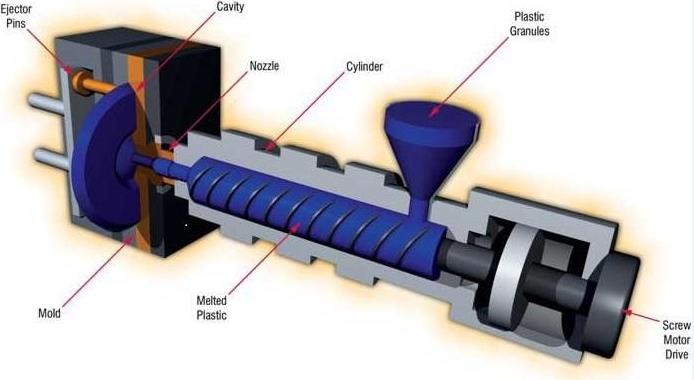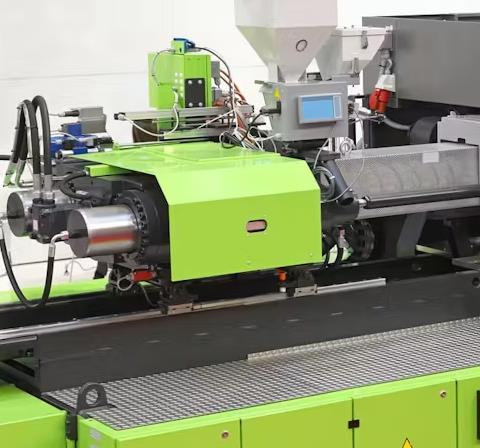The two types of injection molding are “hot runner” and “cold runner” systems, each with its advantages and applications in manufacturing.
Overview of Injection Molding
Definition of Injection Molding
Injection molding stands as a manufacturing process for producing parts by injecting molten material into a mold. This method is especially prevalent for mass-producing plastic parts with intricate shapes. Commonly used materials include thermoplastics, thermosetting polymers, and metals for metal injection molding.

Basic Principles of the Injection Molding Process
The injection molding process unfolds through several key stages:
Melting the Material: The process starts by feeding raw material into a heated barrel to melt it. The power consumption for heating typically ranges from 2.5 kW to 6 kW, depending on the machine and material type.
Injecting into the Mold: Next, the machine injects the molten material into a mold cavity under pressures ranging from 35 to 140 MPa to ensure the material fills all mold areas.
Cooling and Solidifying: After injection, the material cools and solidifies into the desired shape. Cooling times, crucial for the process, can last from a few seconds to minutes, influenced by the part’s size and thickness.
Ejection: Finally, the machine ejects the solidified part from the mold. Designing ejection mechanisms carefully is vital to avoid damaging the part.
The process efficiency is a measure of the cycle time, typically between 15 to 120 seconds. Costs vary, influenced by the complexity of the mold design, material used, and production volume; mold costs can range from $1,000 for simple designs to over $100,000 for complex parts.
Injection molding offers high production rates, consistent part quality, and the ability to create parts with detailed geometries.
For additional details on injection molding, including materials and applications, you can visit the Wikipedia page on Injection Molding.
The Two Types of Injection Molding
Thermoplastic Injection Molding
| Aspect | Details |
|---|---|
| Materials | Uses thermoplastic polymers like Polyethylene, Polypropylene, ABS, and Nylon. |
| Process | Involves heating plastic pellets until they melt, injecting into a mold, cooling, and then ejecting. |
| Reusability | Can be reheated and remolded, allowing for recycling of materials. |
| Cost | Generally less expensive in terms of raw materials. |
| Applications | Widely used in consumer products, automotive components, and medical devices. |
| Advantages | High production speed and ability to reuse materials. |
| Limitations | Not suitable for high-temperature applications as the material can remelt. |
Thermosetting Plastic Injection Molding
| Aspect | Details |
|---|---|
| Materials | Uses thermosetting plastics like Epoxy, Phenolic, and Silicone polymers. |
| Process | Involves injecting the polymer into the mold where it undergoes a chemical reaction to become an infusible solid. |
| Reusability | Cannot be remolded once set, as they undergo a permanent chemical change. |
| Cost | Typically higher cost for raw materials due to the chemical structure and processing. |
| Applications | Common in high-temperature applications like electrical insulators, automotive parts. |
| Advantages | Superior heat resistance and structural integrity at high temperatures. |
| Limitations | Cannot be recycled in the traditional sense, adding to environmental concerns. |
For more comprehensive information on thermoplastic and thermosetting plastics, their properties, and applications, refer to the Wikipedia page on Injection Molding.
Machinery and Equipment in Injection Molding
Equipment Used in Thermoplastic Molding
Thermoplastic injection molding machines typically consist of a hopper, heater, and a plunger or screw-type plunger.
- Hopper: Feeds plastic pellets into the machine.
- Heater: Melts the pellets; uses about 2.5 kW to 6 kW of power.
- Plunger: Injects the molten plastic into the mold under high pressure.
Clamping units are crucial for holding the mold in place during injection. Clamping force can range from 5 to 6,000 tons, depending on the size and complexity of the part. Robotic arms often assist in removing finished parts, enhancing efficiency and safety.
The cost of thermoplastic molding equipment varies. A small machine can cost around $10,000, while larger, more advanced models can exceed $100,000.
Equipment Used in Thermosetting Molding
Thermosetting molding involves similar components but operates under different principles due to the nature of thermosetting plastics.
- Preheating System: Prepares the thermosetting material before injection.
- Injection Unit: This unit must handle higher temperatures than thermoplastic equipment, as it initiates the chemical reaction to set the material.
- Post-Curing Equipment: Often necessary to complete the curing process, ensuring quality and durability.
Thermosetting molding machines require precise control over temperature and timing. The cost for these machines is generally higher, with prices ranging from $15,000 for basic models to over $200,000 for advanced systems.
Both types of equipment have their advantages and limitations. Thermoplastic machines offer versatility and ease of use, whereas thermosetting machines provide products with superior heat resistance and structural strength.
For a deeper dive into the machinery used in injection molding, consider exploring this Wikipedia page.
Environmental and Sustainability Considerations in Injection Molding

Recycling and Reuse in Thermoplastic Molding
Thermoplastic materials, known for their ability to be melted and reshaped multiple times, open avenues for recycling and reuse. This characteristic significantly reduces waste in the manufacturing process. For instance, polyethylene and polypropylene scraps from the injection molding process can be collected, melted, and reformed into new products. Recycling thermoplastics not only cuts down on raw material costs but also lessens environmental impact by reducing landfill waste. However, repeated melting can degrade the material’s quality, which might limit the number of times a thermoplastic can be recycled.
Environmental Impact of Thermosetting Materials
Thermosetting plastics, once set, cannot be remelted and reshaped, posing a challenge for recycling. Their chemical structure, which is permanently set during the initial curing process, makes them non-recyclable through conventional means. This limitation leads to higher environmental concerns as these materials often end up in landfills at the end of their lifecycle. Innovations in chemical recycling methods are being explored to address this issue, but the high cost and complex processes involved are current barriers. The manufacturing of thermosetting plastics also requires careful handling of chemicals, which can be harmful to both workers and the environment if not managed properly.
Both thermoplastic and thermosetting materials have distinct environmental impacts that must be considered in the broader context of sustainable manufacturing practices.
For more detailed insights into the environmental aspects of injection molding, you can explore this Wikipedia page on plastic recycling.




